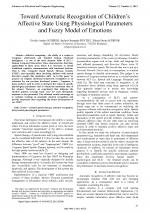| 2/2012 - 8 |
Toward Automatic Recognition of Children's Affective State Using Physiological Parameters and Fuzzy Model of EmotionsSCHIPOR, O.-A. |
| Extra paper information in |
| Click to see author's profile in |
| Download PDF |
Author keywords
assisted speech therapy, emotion recognition, fuzzy model, physiological parameters
References keywords
emotion(11), speech(8), schipor(8), recognition(8), therapy(6), user(5), system(5), pentiuc(5), physiological(4), affect(4)
Blue keywords are present in both the references section and the paper title.
About this article
Date of Publication: 2012-05-30
Volume 12, Issue 2, Year 2012, On page(s): 47 - 50
ISSN: 1582-7445, e-ISSN: 1844-7600
Digital Object Identifier: 10.4316/AECE.2012.02008
Web of Science Accession Number: 000305608000008
SCOPUS ID: 84865304575
Abstract
Affective computing - the ability of a system to recognize, understand and simulate human emotional intelligence - is one of the most dynamic fields of HCI - Human Computer Interaction. These characteristics find their applicability in those areas where it is necessary to extend traditional cognitive communication with emotional features. That is why, Computer Based Speech Therapy Systems (CBST), and especially those involving children with speech disorders, require this qualitative shift. So in this paper we propose an original emotional framework recognition as an extension for our previous developed system - Logomon. A fuzzy model is used in order to interpret the values of specific physiological parameters and to obtain the emotional state of the subject. Moreover, an experiment that indicates the emotion pattern (average fuzzy sets) for each therapeutic sequence is also presented. The obtained results encourage us to continue working on automatic emotion recognition and provide important clues regarding the future development of our CBST. |
| References | | | Cited By |
Web of Science® Times Cited: 8 [View]
View record in Web of Science® [View]
View Related Records® [View]
Updated today
SCOPUS® Times Cited: 5
View record in SCOPUS® [Free preview]
View citations in SCOPUS® [Free preview]
[1] Fuzzy Integral and Cuckoo Search Based Classifier Fusion for Human Action Recognition, AYDIN, I., Advances in Electrical and Computer Engineering, ISSN 1582-7445, Issue 1, Volume 18, 2018.
Digital Object Identifier: 10.4316/AECE.2018.01001 [CrossRef] [Full text]
[2] Parkinson's disease Assessment using Fuzzy Expert System and Nonlinear Dynamics, GEMAN, O., TURCU, C. O., GRAUR, A., Advances in Electrical and Computer Engineering, ISSN 1582-7445, Issue 1, Volume 13, 2013.
Digital Object Identifier: 10.4316/AECE.2013.01007 [CrossRef] [Full text]
[3] Software Architecture Design for Spatially-Indexed Media in Smart Environments, SCHIPOR, O.-A., WU, W., TSAI, W.-T., VATAVU, R.-D., Advances in Electrical and Computer Engineering, ISSN 1582-7445, Issue 2, Volume 17, 2017.
Digital Object Identifier: 10.4316/AECE.2017.02003 [CrossRef] [Full text]
[4] GearWheels: A Software Tool to Support User Experiments on Gesture Input with Wearable Devices, Schipor, Ovidiu-Andrei, Vatavu, Radu-Daniel, International Journal of Human–Computer Interaction, ISSN 1044-7318, Issue 18, Volume 39, 2023.
Digital Object Identifier: 10.1080/10447318.2022.2098907 [CrossRef]
[5] SAPIENS, Schipor, Ovidiu-Andrei, Vatavu, Radu-Daniel, Wu, Wenjun, Proceedings of the ACM on Human-Computer Interaction, ISSN 2573-0142, Issue EICS, Volume 3, 2019.
Digital Object Identifier: 10.1145/3331153 [CrossRef]
Disclaimer: All information displayed above was retrieved by using remote connections to respective databases. For the best user experience, we update all data by using background processes, and use caches in order to reduce the load on the servers we retrieve the information from. As we have no control on the availability of the database servers and sometimes the Internet connectivity may be affected, we do not guarantee the information is correct or complete. For the most accurate data, please always consult the database sites directly. Some external links require authentication or an institutional subscription.
Web of Science® is a registered trademark of Clarivate Analytics, Scopus® is a registered trademark of Elsevier B.V., other product names, company names, brand names, trademarks and logos are the property of their respective owners.
Faculty of Electrical Engineering and Computer Science
Stefan cel Mare University of Suceava, Romania
All rights reserved: Advances in Electrical and Computer Engineering is a registered trademark of the Stefan cel Mare University of Suceava. No part of this publication may be reproduced, stored in a retrieval system, photocopied, recorded or archived, without the written permission from the Editor. When authors submit their papers for publication, they agree that the copyright for their article be transferred to the Faculty of Electrical Engineering and Computer Science, Stefan cel Mare University of Suceava, Romania, if and only if the articles are accepted for publication. The copyright covers the exclusive rights to reproduce and distribute the article, including reprints and translations.
Permission for other use: The copyright owner's consent does not extend to copying for general distribution, for promotion, for creating new works, or for resale. Specific written permission must be obtained from the Editor for such copying. Direct linking to files hosted on this website is strictly prohibited.
Disclaimer: Whilst every effort is made by the publishers and editorial board to see that no inaccurate or misleading data, opinions or statements appear in this journal, they wish to make it clear that all information and opinions formulated in the articles, as well as linguistic accuracy, are the sole responsibility of the author.



